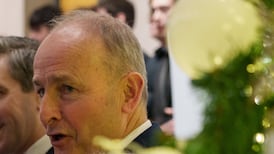When considering homophobia – and, by golly, we are considering homophobia this week – it’s always worth returning to Quentin Crisp’s anecdote about the man who hated a certain garden vegetable. “I don’t like peas, and I’m glad I don’t like them, because if I liked them I would eat them and I hate them,” the fictional fellow argued. Mr Crisp’s point was that much homophobia springs from the bigot’s distaste for the mechanics of gay sex. Somehow or other, a harmless aesthetic preference (I don’t much fancy that myself) turns into a discriminatory crusade (I think that is morally wrong).
Anyway, why listen to me when, courtesy of YouTube, you can access Panti Bliss’s stirring speech at the Abbey Theatre last week? “For the last three weeks I have been lectured to about what homophobia is and who is allowed to identify it,” Bliss said. Good point.
There are still threads to be unravelled from the controversy that sprung up following the interview with Rory O'Neill, the drag queen's alter ego, on the Saturday Night Show. But what interests us here is the peculiar, surprising and hugely welcome resonance of that oration. Stephen Fry and Graham Norton have given thumbs up. It has since been trending all over the planet.
This wasn’t supposed to happen any more. If we know anything about modern discourse we know that the formal speech is as outmoded a form as the madrigal or the mystery play. Yes, a single speaker can move a crowd. There were, indeed, powerful speeches at the rally against homophobia in Dublin last week. But mainstream politics now works through soundbites, broad imagery and digital insinuation. Who the heck has time to listen to a speech? Puppies in buckets go viral on Twitter. Delicately worded entreaties for tolerance belong to another era.
Monster meeting
The public oration was at its most potent before mass media and mass literacy. The term "monster meeting" was coined to describe the huge rallies addressed by Daniel O'Connell during the fight for Catholic emancipation. It is said that as many as 100,000 people would turn out to hear the Liberator explain his case. Obviously, nobody could skip the real thing and wait for the highlights on telly. Indeed, many would not be able to read published reports in the newspaper. On reflection, it is wrong to say that such meetings preceded mass media. They were mass media.
Mind you, the oration retained its potency well into the 20th century. Addressing a large crowd and a much larger radio audience, Franklin Delano Roosevelt, during his inauguration speech, managed to captivate audiences as he (somewhat tendentiously) assured them the only thing they needed to be frightened of was being frightened. Churchill's great war-time speeches – featuring those odd, apparently random inflections – were delivered to the radio audience alone.
By the late 1960s, while the odd zealot speaking to an equally zealous audience could still inspire ferment, television was beginning to eat away at the art of full-on oratory. No broadcaster wanted to set aside five or 10 minutes for nothing but one-voiced wittering. There are darts to be watched. There are game shows to be hosted. When Neil Kinnock ascended to the UK Labour Party's leadership in 1983, apparatchiks noted he had the same gift for near-ecclesiastical oratory that characterised earlier Welsh politicians such as Aneurin Bevan. That was all very well at the party conference. But the confining nature of television and the nervous constitutions of its producers demand short soundbites delivered in conversational prose.
Modern oration
So, how do we explain Barack Obama? It is, perhaps, no great coincidence that the best presidential orator in several generations arrived in the age of YouTube and social media. Suddenly, voters could be their own editors. No broadcaster needed to set aside an entire evening for a speech. The user, alerted to an interesting oration by his pal, could hurriedly reschedule that Angry Birds game to Friday morning and that puppy in a bucket to the late-night slot.
All of which goes some way to explaining how, despite the apparent creakiness of the medium, Panti Bliss managed to spread a message of tolerance so effectively. None of this would, of course, have mattered if Bliss weren't such an extraordinarily effective orator. All such speakers have their style: Martin Luther King used the rhythms of the liturgy; Churchill rumbled like a closing storm; Christopher Hitchens treated oratory like a bloodsport. Bliss's great gift is a talent for intimacy. Bliss strolls on to the stage and addresses the Abbey audience as if it's a party of six gathered for a coffee morning. Then Bliss leans in and gently – almost sweetly – twists a benevolent stiletto in the listener's side.
This ancient art will never die.











